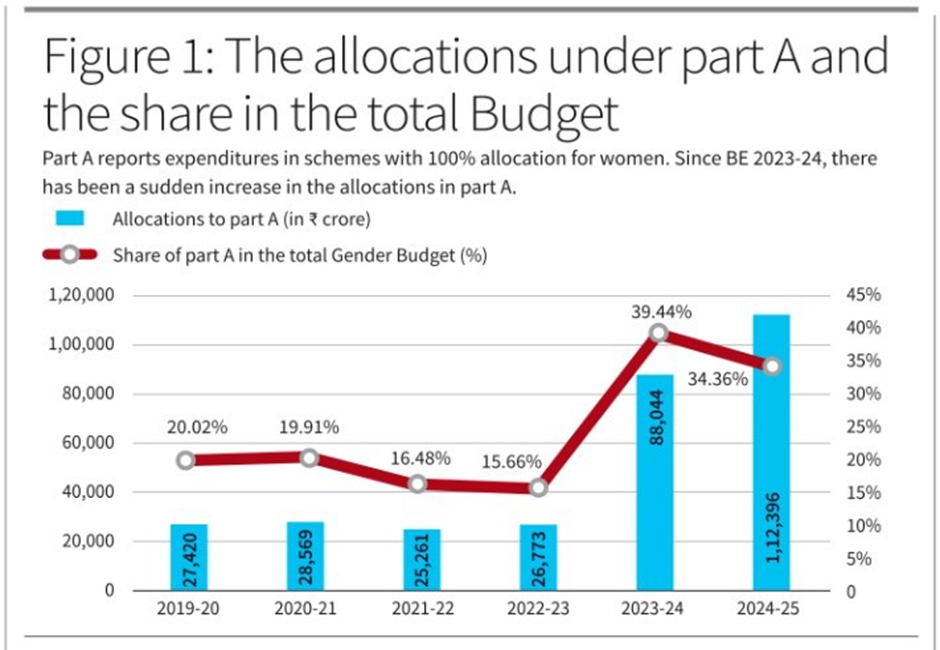- Courses
- GS Full Course 1 Year
- GS Full Course 2 Year
- GS Full Course 3 Year
- GS Full Course Till Selection
- Online Program
- GS Recorded Course
- NCERT (Recorded 500+ Hours)
- Polity Recorded Course
- Geography Recorded Course
- Economy Recorded Course
- AMAC Recorded Course
- Modern India, Post Independence & World History
- Environment Recoded Course
- Governance Recoded Course
- Science & Tech. Recoded Course
- International Relations and Internal Security Recorded Course
- Disaster Management Module Course
- Ethics Recoded Course
- Essay Recoded Course
- Current Affairs Recoded Course
- CSAT
- 5 LAYERED ARJUNA Mentorship
- Public Administration Optional
- ABOUT US
- OUR TOPPERS
- TEST SERIES
- FREE STUDY MATERIAL
- VIDEOS
- CONTACT US
Gender Budget Statement 2024-25
Gender Budget Statement 2024-25
01-09-2024

Why in News?
The 2024-25 Union Budget highlights a significant push for women-led development. The Gender Budget Statement (GBS) for this fiscal year marks a milestone by allocating 1% of the Gross Domestic Product (GDP) to pro-women funding, with a total exceeding ₹3 lakh crore. This is a noteworthy increase from historical averages and reflects the government’s commitment to gender-focused financial planning.
Key Highlights of the GBS 2024-25
-
Increased Pro-Women Allocations:
- For the fiscal year 2024-25, the allocation for pro-women schemes has risen to about 6.8% of the total budget expenditure. This is an improvement from the historical average of approximately 5%, indicating a stronger focus on women-centric programs.
-
New Reporting Structure - Part C:
- The GBS now includes a new section, Part C, which accounts for schemes with up to 30% allocation for women, such as the PM Kisan scheme. This addition aims to provide a more detailed view of gender-specific allocations.
-
Revised Structure of GBS:
- Part A: This includes schemes with 100% allocation for women, such as SAMARTHYA and the Pradhan Mantri Awas Yojana (PMAY), which together now make up nearly 40% of the GBS allocations.
- Part B: Covers schemes with 30% to 99% expenditure on women-related components, such as PM AJAY - Adarsh Gram Yojana.
What is Gender Budgeting?
- Definition: Gender budgeting is a strategic approach used by governments to allocate resources based on the diverse needs and priorities of different genders. It aims to address gender-specific needs within existing budget frameworks rather than creating separate budgets exclusively for women.
- Background:
- India’s commitment to gender equality, as signaled by its ratification of CEDAW in 1993, led to the introduction of the first Gender Budget Statement in 2005-2006. The Ministry of Women and Child Development (MWCD) oversees this process, with the Ministry of Finance mandating the establishment of Gender Budget Cells in various departments.
- Framework:
- Situation Analysis: Assessing gender status in various sectors.
- Policy Assessment: Evaluating the responsiveness of policies to gender issues.
- Budget Evaluation: Ensuring adequate budget allocations for gender-sensitive measures.
- Expenditure Monitoring: Verifying the use of funds and assessing results.
- Impact Assessment: Measuring the impact of policies on gender conditions.
Significance of Gender Budgeting:
- Optimizes Resource Allocation: Ensures funds are directed to areas where gender gaps are significant, addressing critical needs.
- Supports SDGs: Aligns with Sustainable Development Goal 5, contributing to global gender equality efforts.
- Enhances Accountability: Provides transparency in fund allocation and usage, ensuring gender equality commitments are met.
- Strengthens Governance: Integrates gender perspectives into financial management, leading to more inclusive governance.
Challenges Related to Gender Budgeting in India:
-
Over-Reporting:
- Some programs, such as the PM Employment Generation Programme (PMEGP), report inflated allocations without adequate justification. This challenges the credibility of the GBS.
-
Under-Reporting and Missing Allocations:
- Critical allocations for women’s needs are often understated. For instance, the MGNREGS, which benefits women significantly, reports only 33.6% of its budget for women-related components despite women accounting for 59.3% of the workforce under the scheme. Schemes for women entrepreneurs like PM Vishwakarma and Stand-Up India are also not fully reported.
-
Neglect of Key Sectors:
- Sectors with significant impact on women, such as transportation and water security, often receive inadequate attention in gender budgeting.
Way Forward:
-
Enhance Reporting Transparency and Accuracy:
- Improve gender audits and provide detailed explanations for all entries in the GBS. Address discrepancies in reporting and ensure accurate reflection of expenditures on women’s needs.
-
Expand Scope and Coverage:
- Broaden the scope to include more comprehensive coverage of programs affecting women, especially in neglected areas like transportation and water security.
-
Regular Reviews and Updates:
- Update GBS methodologies regularly to incorporate the latest data and insights. Conduct periodic reviews to assess the effectiveness of gender-responsive budgeting.
-
Integrate Gender Sensitivity in Planning:
- Set clear gender equality targets and allocate resources to ensure government programs are designed with gender considerations from the outset.
By addressing these challenges and implementing the suggested improvements, India can enhance the effectiveness of gender budgeting and ensure that financial resources are more equitably distributed to support women’s development.
Must Check: Best IAS Coaching In Delhi
UPSC Prelims Result 2024 Out: Expected Cut Off & Other Details, UPSC Prelims 2024 Answer with Explanation, Daily Prelims Quiz, Daily Current Affairs, MONTHLY CURRENT AFFAIRS TOTAL (CAT) MAGAZINE, Best IAS Coaching Institute in Karol Bagh, Best IAS Coaching Institute in Delhi, Daily Mains Question Answer Practice, ENSURE IAS UPSC Toppers, UPSC Toppers Marksheet, Previous Year Interview Questions, UPSC Syllabus




